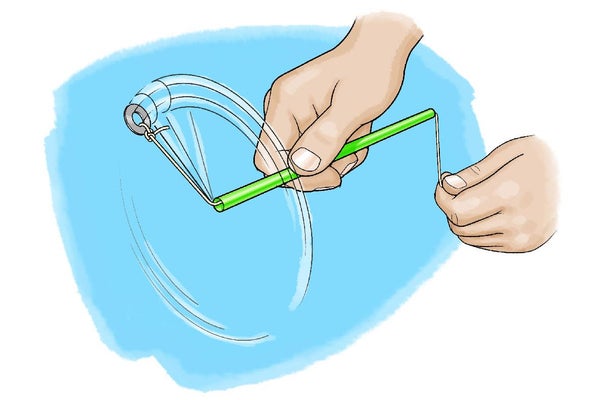Key concepts
Physics
Angular momentum
Tension
Introduction
You might have seen figure skaters spinning around quickly and then tucking their arms to spin faster—or opening them to spin more slowly. This happens, thanks to a physics concept known as the “conservation of angular momentum.” But how can you try it out if you don’t have any ice skates around? Find out in this simple activity that only requires common household supplies!
Background
Have you ever heard of Newton's first law of motion? It states that an object at rest (not moving) will remain at rest and a moving object will keep moving—unless they are acted on by an outside force. This means that an object's momentum (its mass times its velocity) will stay the same unless an outside force acts on it somehow. You experience this every day. For example, imagine catching a ball. When the ball is moving, it has momentum. You have to exert a force with your hand to stop the ball (and bring its momentum down to zero). If the ball is heavier or moving faster, it has more momentum, and is harder to catch—you have to exert a bigger force.
On supporting science journalism
If you're enjoying this article, consider supporting our award-winning journalism by subscribing. By purchasing a subscription you are helping to ensure the future of impactful stories about the discoveries and ideas shaping our world today.
This concept is usually described in relation to objects moving in a straight line, but it also applies to spinning objects. The terminology is a little different when we talk about spinning objects. Instead of forces, which are pushes or pulls that act in a straight line, we refer to torque, which is a “twist” applied to an object (think: twisting a screwdriver or a doorknob). Instead of mass, we refer to moment of inertia, which measures how spread out the mass is about the point of rotation. Instead of velocity we say, “angular velocity,” which measures how fast an object rotates. Finally, instead of momentum, we say “angular momentum.”
Even though the terms are a little different the same concepts apply. The angular momentum of a spinning object will remain the same unless an outside torque acts on it. In physics when something stays the same we say it is conserved. That's where the phrase “conservation of angular momentum” comes from. The classic example of this is a spinning ice skater or someone spinning in an office chair. By pulling in her arms, the skater decreases her moment of inertia (all her mass is closer to the middle), so her angular velocity has to increase in order to keep her angular momentum constant.
This can be difficult to demonstrate if you don't have ice skates or a spinning office chair handy, however. In this project you will demonstrate conservation of angular momentum using a straw, string and small object.
Materials
Straw
String
Washer or other small, heavy object
Scissors
Preparation
Cut the string to a length of about one meter.
Procedure
Thread the string through the straw.
Tie one end of the string to the washer.
Hold the straw in one hand, and the free end of the string in your other hand.
Let the washer dangle down from the other end of the straw.
Gently twirl the straw so the washer spins in a circle. Make sure you spin it fast enough that there is no slack in the string.
Slowly pull the string through the straw, bringing the washer closer to the straw. What happens?
Now try the opposite. Start with the washer pulled in very close to the straw. Start twirling it, then gradually let the string get looser so the washer can move farther away. What happens?
Extra: Cut a longer length of string, and go outside into an open space so you can twirl the washer over your head without hitting anything. Do your results change at all?
Observations and results
When you start twirling the straw with the washer far away from the center and then pull the string through the straw you should notice that the washer spins faster. This happens because angular momentum is conserved. Angular momentum is an object's moment of inertia times its angular velocity. If one of the latter two increases, the other decreases, and vice versa. When you pull the string through the straw, bringing the washer closer, you decrease its moment of inertia. (That is, you bring its mass closer to the point of rotation.) To compensate and keep angular momentum constant, the washer's angular velocity has to increase. The reverse happens when you loosen the string and allow the washer to move out farther. Its moment of inertia increases, so for angular momentum to remain constant, the rotational speed has to decrease.
More to explore Swiveling Science: Conserving Momentum in a Spinning Chair, from Scientific American Gravity-Defying Water, from Scientific American Science Activities for All Ages!, from Science Buddies
Science Buddies
This activity brought to you in partnership with Science Buddies

